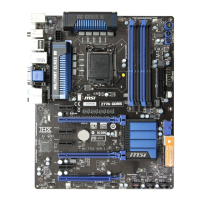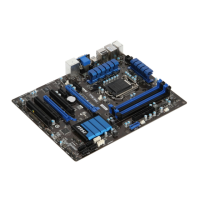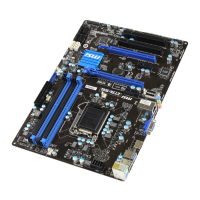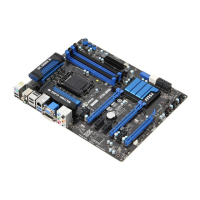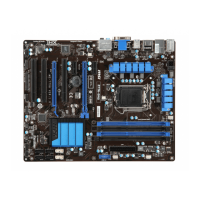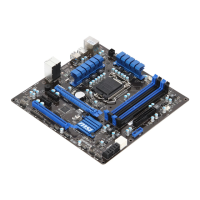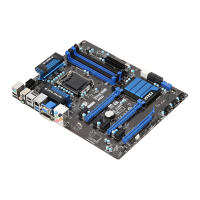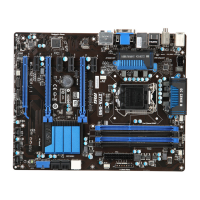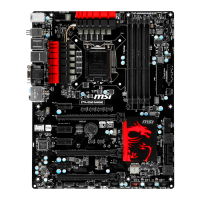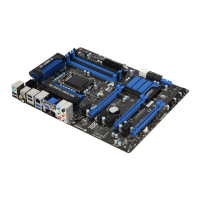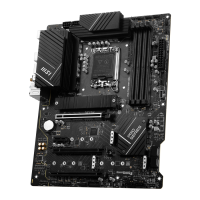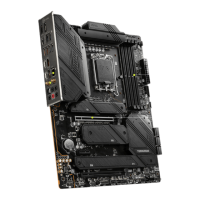Do you have a question about the MSI Z77A and is the answer not in the manual?
Information about document ownership and intellectual property rights.
Lists registered trademarks used in the manual and their owners.
Records changes and updates made to the document over time.
Provides contact information and resources for technical assistance.
Guidelines and precautions to ensure safe operation and prevent damage.
Compliance statement regarding radio frequency interference.
Guidelines for proper disposal and handling of batteries.
Information on chemical substances in compliance with regulations.
Environmental statement regarding disposal of electronic equipment.
Lists the items included in the mainboard package.
Shows optional accessories that can be purchased separately.
Important safety guidelines and precautions before installing components.
Detailed technical specifications of the mainboard.
Identifies and describes the back panel and onboard connectors and buttons.
Visual guide to the location of various connectors on the mainboard.
Detailed reference for each port and connector on the mainboard.
Visual guide and description of the back panel connectors.
Details about the LAN port and its LED indicators.
Description of the HDMI interface for audio-video transmission.
Description of the VGA port for monitor connection.
Description of the DVI-D port for monitor connection.
Describes the audio jacks and their functions.
Introduction to the LGA 1155 CPU and installation considerations.
Step-by-step guide for installing the CPU and cooler.
Instructions on how to mount the mainboard in the computer case.
Details on connecting the ATX 24-pin and 8-pin power connectors.
Information on DDR3 memory modules and dual-channel mode.
Step-by-step guide for installing memory modules into DIMM slots.
Describes the PCIe slots and their types for expansion cards.
Instructions for installing discrete video or graphics cards.
Guide to installing and configuring AMD CrossFire for multi-GPU setups.
Guide to installing and configuring NVIDIA SLI for multi-GPU setups.
Details on internal SATA connectors and their usage.
Explains the fan power connectors and their pinouts.
Describes front panel connectors for power switches, LEDs, and reset.
Instructions for connecting the front panel audio ports.
Details on connecting USB 2.0 devices via expansion headers.
Details on connecting USB 3.0 devices via expansion headers.
Explains the chassis intrusion detection connector.
Describes the connector for a Trusted Platform Module.
Describes the serial port connector for legacy devices.
Information about the Clear CMOS Jumper (JBAT1) and its function.
Describes the CPU_PHASE LEDs and their function.
How to access the BIOS Setup menu using DEL or F11 keys.
Overview of the BIOS interface elements and their functions.
Explains keyboard hotkeys and mouse operations for navigating BIOS.
Main menu for system settings, date, time, and SATA ports.
Advanced BIOS settings for PCI, PCIE, ACPI, and integrated peripherals.
Settings for configuring integrated graphics adapter and memory.
Enables or disables Intel Rapid Start Technology for faster boot.
Settings for USB controllers, legacy support, and device configuration.
Monitors system hardware like CPU and fan speeds.
Controls CPU fan speed based on temperature.
Displays current hardware status including temperatures and fan speeds.
Configure power saving modes and behavior after AC power loss.
Configure system wake-up events via RTC alarm or devices.
Settings related to boot sequence and boot options.
Overclocking settings for CPU and DRAM.
Highlights key CPU features and specifications (read-only).
Displays detailed settings and timings of installed DIMMs (read-only).
Allows selection of active processor cores and other CPU features.
Select the number of active processor cores.
Prevents malicious buffer overflow attacks.
Enhances virtualization, allowing multiple virtual systems.
Settings for energy saving modes and power management.
Instructions for using the MSI Winki browser application.
Step-by-step guide for installing the Winki application.
Overview of system utilities like HDD Backup and Live Update.
Utility for BIOS boot function and flashing.
Guide on how to update the BIOS using the Live Update utility.
Settings for system security, including passwords and USB key protection.
Enables or disables chassis intrusion detection.
Step-by-step guide for installing the audio driver.
How to configure the Realtek HD Audio Manager for audio output.
Selecting audio output sources and setting defaults.
Adjusting speaker volume and balance.
Diagrams showing default audio back panel connections.
Overview of SATA hard drives and Intel RAID controller features.
How to enter and use the Intel RAID configuration utility.
Step-by-step guide to creating a RAID volume.
Instructions for deleting a RAID volume and its data.
How to reset RAID disks back to non-RAID configuration.
Options for managing recovery volumes.
Guide for installing Intel RAID drivers during OS setup.
Installing Intel RAID drivers in an existing Windows installation.
Verifying the correct installation of Intel RAID drivers.
Procedure for rebuilding a degraded RAID array.
How to enable system acceleration using an SSD as cache.
Manually synchronizing data between SSD cache and hard disk.
Information about document ownership and intellectual property rights.
Lists registered trademarks used in the manual and their owners.
Records changes and updates made to the document over time.
Provides contact information and resources for technical assistance.
Guidelines and precautions to ensure safe operation and prevent damage.
Compliance statement regarding radio frequency interference.
Guidelines for proper disposal and handling of batteries.
Information on chemical substances in compliance with regulations.
Environmental statement regarding disposal of electronic equipment.
Lists the items included in the mainboard package.
Shows optional accessories that can be purchased separately.
Important safety guidelines and precautions before installing components.
Detailed technical specifications of the mainboard.
Identifies and describes the back panel and onboard connectors and buttons.
Visual guide to the location of various connectors on the mainboard.
Detailed reference for each port and connector on the mainboard.
Visual guide and description of the back panel connectors.
Details about the LAN port and its LED indicators.
Description of the HDMI interface for audio-video transmission.
Description of the VGA port for monitor connection.
Description of the DVI-D port for monitor connection.
Describes the audio jacks and their functions.
Introduction to the LGA 1155 CPU and installation considerations.
Step-by-step guide for installing the CPU and cooler.
Instructions on how to mount the mainboard in the computer case.
Details on connecting the ATX 24-pin and 8-pin power connectors.
Information on DDR3 memory modules and dual-channel mode.
Step-by-step guide for installing memory modules into DIMM slots.
Describes the PCIe slots and their types for expansion cards.
Instructions for installing discrete video or graphics cards.
Guide to installing and configuring AMD CrossFire for multi-GPU setups.
Guide to installing and configuring NVIDIA SLI for multi-GPU setups.
Details on internal SATA connectors and their usage.
Explains the fan power connectors and their pinouts.
Describes front panel connectors for power switches, LEDs, and reset.
Instructions for connecting the front panel audio ports.
Details on connecting USB 2.0 devices via expansion headers.
Details on connecting USB 3.0 devices via expansion headers.
Explains the chassis intrusion detection connector.
Describes the connector for a Trusted Platform Module.
Describes the serial port connector for legacy devices.
Information about the Clear CMOS Jumper (JBAT1) and its function.
Describes the CPU_PHASE LEDs and their function.
How to access the BIOS Setup menu using DEL or F11 keys.
Overview of the BIOS interface elements and their functions.
Explains keyboard hotkeys and mouse operations for navigating BIOS.
Main menu for system settings, date, time, and SATA ports.
Advanced BIOS settings for PCI, PCIE, ACPI, and integrated peripherals.
Settings for configuring integrated graphics adapter and memory.
Enables or disables Intel Rapid Start Technology for faster boot.
Settings for USB controllers, legacy support, and device configuration.
Monitors system hardware like CPU and fan speeds.
Controls CPU fan speed based on temperature.
Displays current hardware status including temperatures and fan speeds.
Configure power saving modes and behavior after AC power loss.
Configure system wake-up events via RTC alarm or devices.
Settings related to boot sequence and boot options.
Overclocking settings for CPU and DRAM.
Highlights key CPU features and specifications (read-only).
Displays detailed settings and timings of installed DIMMs (read-only).
Allows selection of active processor cores and other CPU features.
Select the number of active processor cores.
Prevents malicious buffer overflow attacks.
Enhances virtualization, allowing multiple virtual systems.
Settings for energy saving modes and power management.
Instructions for using the MSI Winki browser application.
Step-by-step guide for installing the Winki application.
Overview of system utilities like HDD Backup and Live Update.
Utility for BIOS boot function and flashing.
Guide on how to update the BIOS using the Live Update utility.
Settings for system security, including passwords and USB key protection.
Enables or disables chassis intrusion detection.
Step-by-step guide for installing the audio driver.
How to configure the Realtek HD Audio Manager for audio output.
Selecting audio output sources and setting defaults.
Adjusting speaker volume and balance.
Diagrams showing default audio back panel connections.
Overview of SATA hard drives and Intel RAID controller features.
How to enter and use the Intel RAID configuration utility.
Step-by-step guide to creating a RAID volume.
Instructions for deleting a RAID volume and its data.
How to reset RAID disks back to non-RAID configuration.
Options for managing recovery volumes.
Guide for installing Intel RAID drivers during OS setup.
Installing Intel RAID drivers in an existing Windows installation.
Verifying the correct installation of Intel RAID drivers.
Procedure for rebuilding a degraded RAID array.
How to enable system acceleration using an SSD as cache.
Manually synchronizing data between SSD cache and hard disk.
| CPU Socket | LGA 1155 |
|---|---|
| Chipset | Intel Z77 |
| Memory Type | DDR3 |
| Memory Slots | 4 |
| Maximum Memory Supported | 32GB |
| Form Factor | ATX |
| Memory Speed | 1066/1333/1600/1866 MHz |
| SATA 3Gb/s Ports | 4 |
| USB 3.0 Ports | 4 |
| Onboard Video | Yes (via CPU) |
| Onboard LAN | Realtek 8111E |
